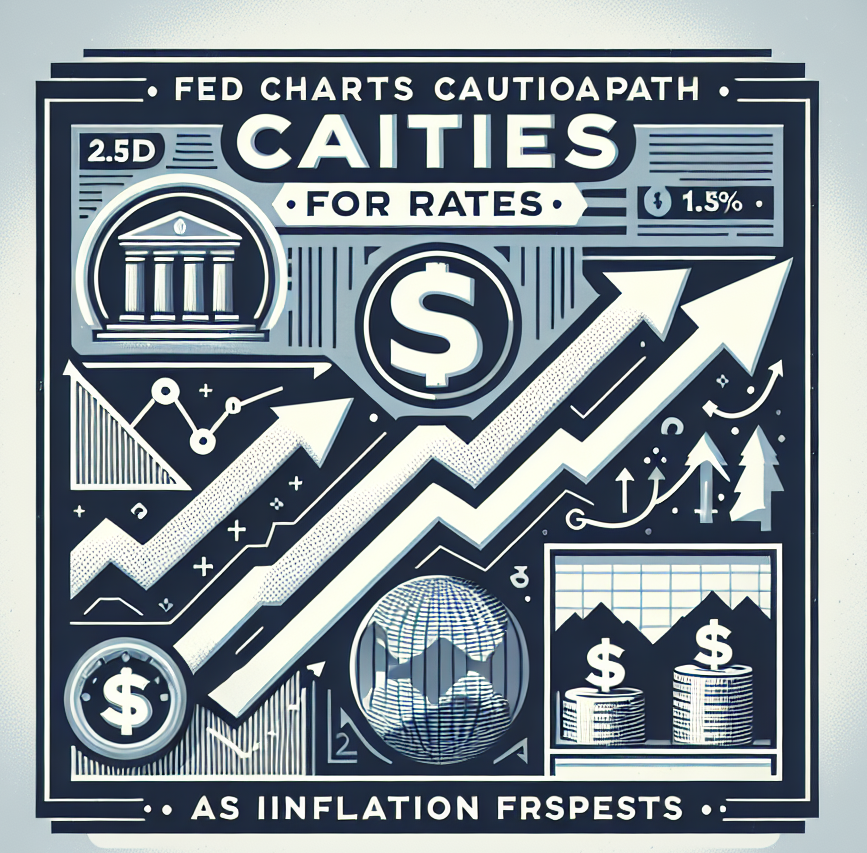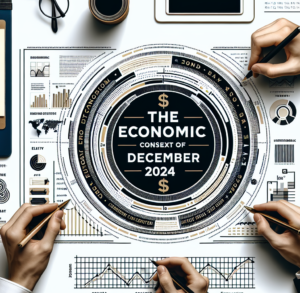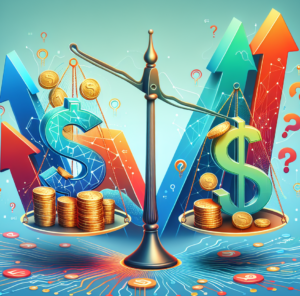
In recent months, the Federal Reserve (Fed) has charted a more cautious path for future interest rate hikes as inflation continues to remain stubbornly high. Despite aggressive rate hikes earlier in 2024, inflation remains above target, posing a significant challenge to the central bank’s efforts to maintain economic stability. This article explores the Fed’s evolving strategy to balance its dual mandate of price stability and maximum employment while navigating the complex economic environment of late 2024.
Understanding the Federal Reserve’s Mandate and Tools
The Federal Reserve has a dual mandate: to promote maximum employment and ensure price stability, with an inflation target of 2%. This mandate shapes the Fed’s monetary policy, primarily through adjustments to the federal funds rate, which is the interest rate at which banks lend to each other overnight. Changes in the federal funds rate influence borrowing costs for consumers and businesses, affecting demand in the economy.
The Role of Interest Rates in Managing Inflation
Interest rates are the Federal Reserve’s primary tool for controlling inflation. When the economy experiences inflationary pressures, the Fed raises interest rates to make borrowing more expensive, which, in turn, slows down spending and investment. Conversely, when inflation is low or the economy is in a downturn, the Fed lowers rates to stimulate borrowing and investment.
The decision to increase rates is particularly challenging when inflation is persistent, as it affects economic growth and employment levels. The Fed must carefully consider the broader economic implications of its actions, as tightening too much could stifle growth, while insufficient action could lead to runaway inflation.
The Economic Context of December 2024
As of December 2024, inflation remains a pressing concern for the U.S. economy. The Consumer Price Index (CPI) has shown inflation running at approximately 3.5% year-over-year, well above the Fed’s target of 2%. Despite a series of rate hikes throughout 2024, inflationary pressures have not abated as expected, and the economy is showing signs of slowing down.
Key Drivers of Persistent Inflation
Several factors contribute to the persistent inflation that has plagued the U.S. economy. First, high energy prices remain a significant contributor to rising costs. Global supply chain disruptions, particularly in the wake of geopolitical tensions and trade disruptions, have driven up the costs of goods and services. In addition, wage growth has remained strong, particularly in sectors facing labor shortages, which has contributed to rising costs for businesses.
The impact of these factors on the economy has been profound. While some inflationary pressures, such as supply chain disruptions, are beginning to ease, high energy costs and wages continue to exert upward pressure on prices. This complicates the Fed’s efforts to bring inflation back to its 2% target.
Global Economic Influences
Inflation in the U.S. is also influenced by global factors. For instance, energy prices are highly susceptible to geopolitical instability. OPEC’s decisions to reduce oil production in late 2024, combined with rising tensions in key oil-producing regions, have contributed to higher energy prices. These external factors make it difficult for the Fed to control inflation through domestic interest rate policy alone.
In addition, the ongoing trade disruptions caused by geopolitical tensions between the U.S., China, and Europe have affected global supply chains, leading to higher costs for imported goods. These factors contribute to the overall inflationary environment, forcing the Fed to weigh domestic policies against global economic trends.
The Fed’s Response: A More Cautious Approach
The Fed’s response to inflation in 2024 has evolved over the course of the year. Initially, the Fed adopted a more aggressive stance, implementing several interest rate hikes in an effort to curb inflation. However, the persistence of inflation, coupled with signs of a slowing economy, has led the Fed to reassess its approach.
Comments from Fed Officials
Several Fed officials have remarked on the need for a more measured approach to interest rates. In December 2024, Fed Chairman Jerome Powell reiterated that the central bank must be cautious in its rate decisions, acknowledging that high inflation may not be easily brought under control. He stressed that further rate hikes could risk tipping the economy into a recession.
Other officials, such as San Francisco Fed President Mary Daly, have also highlighted the importance of waiting for more data before making additional policy changes. While there is still a consensus that inflation must be reduced, there is growing recognition that the Fed must avoid over-tightening, which could lead to significant economic disruption.
Caution Amid Signs of Economic Slowdown
Economic data in late 2024 points to a potential slowdown. Retail sales have weakened, and consumer confidence has declined. The housing market, which had been a major driver of economic activity, is also showing signs of cooling due to higher mortgage rates. These signs of economic slowdown are prompting the Fed to be more cautious about its future actions.
While inflation is still high, there is growing concern that continued rate hikes could exacerbate economic weakness. As a result, the Fed is now prioritizing a more balanced approach, carefully weighing inflation data against broader economic conditions.
A Shift Toward Data-Driven Decisions
The Fed’s decision-making process is highly data-driven. Economic indicators such as unemployment rates, GDP growth, and inflation trends are closely monitored to inform policy decisions. The Fed’s cautious approach in December 2024 is driven by its commitment to analyzing data before making further moves on interest rates.
Fed officials are also paying close attention to wage growth, which has remained strong despite higher interest rates. This suggests that inflation may be more entrenched than initially anticipated, requiring a more nuanced approach to rate hikes.
Challenges in Managing Inflation and Economic Growth
The Fed’s task of managing inflation while ensuring economic growth is becoming increasingly difficult. The U.S. economy is showing signs of strain, and while inflation remains high, the central bank must be careful not to push the economy into a recession.
The Risk of Over-tightening
The risk of over-tightening is a key concern for the Fed. By continuing to raise interest rates, the Fed could potentially slow down economic activity too much, leading to a contraction in GDP growth and higher unemployment rates. This could ultimately reverse the progress made in achieving full employment, a core goal of the Fed’s mandate.
Balancing Inflation Control and Economic Stability
The Fed’s cautious stance reflects its need to balance inflation control with economic stability. While controlling inflation is paramount, the Fed must also consider the long-term effects of its policy decisions on employment and growth. Economic stability, after all, is key to achieving sustainable inflation levels in the long run.
The broader economic context, including the impact of global supply chains and energy prices, must also be factored into the Fed’s decisions. The reality is that the central bank’s ability to control inflation is limited by factors beyond its control, and a cautious approach allows the Fed to remain flexible in responding to unforeseen economic developments.
Looking Ahead: The Future of Fed Policy
As we move into 2025, the outlook for the Fed’s policy remains uncertain. While inflation is still above target, there are indications that it may begin to ease as supply chains recover and energy prices stabilize. In the meantime, the Fed is likely to maintain a cautious approach, waiting for further signs of inflationary relief before making additional rate cuts.
Predictions for 2025
Some economists predict that the Fed will hold interest rates steady in early 2025, with any rate cuts potentially coming later in the year. However, much depends on the evolution of inflation and economic growth. If inflation continues to show signs of slowing down, the Fed may consider rate cuts, but it will proceed carefully to avoid jeopardizing the recovery.
The Role of Global Economic Factors
The global economy will continue to play a significant role in shaping the Fed’s decisions. Geopolitical instability, energy price fluctuations, and global supply chain disruptions will all influence inflation trends in the U.S. The Fed will need to adapt its policies to account for these external factors while staying committed to its dual mandate of price stability and maximum employment.
In conclusion, the Federal Reserve’s cautious approach to interest rates in December 2024 reflects the complexity of the current economic environment. High inflation, coupled with signs of a slowing economy, has forced the Fed to carefully consider its next moves. While inflation remains a key concern, the Fed’s decision-making process is increasingly shaped by the broader economic context and global factors.
Looking ahead, the Fed will continue to monitor economic indicators closely, adjusting its policies as needed to strike a balance between controlling inflation and supporting economic growth. With global economic uncertainty continuing to loom large, the Fed’s careful navigation of these challenges will be critical to maintaining stability in the U.S. economy in 2025 and beyond.
Visit our other website: https://synergypublish.com



